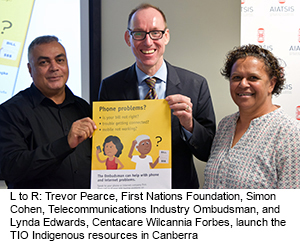TIO launches toolkit to assist Indigenous consumers

The kit consists of a flipchart, posters, and a brochure outlining how workers and community residents can contact the TIO if they cannot resolve a problem with their landline, mobile or Internet service provider.
Ombudsman Simon Cohen launched the kit at Financial Counselling Australia’s Aboriginal and Torres Strait Islander (ATSI) forum part of the national Financial Counselling Australia Conference.
More than 50 Indigenous financial counsellors from around Australia attended the forum.
A study by Charles Darwin University in 2012 of three remote Indigenous communities in the Northern Territory, found that between 60 and 80 per cent of people over ten years of age in each community owned a mobile phone and used it regularly, even in the one community where there was no reception*.
The TIO surveyed organisations such as financial counsellors, health and government workers, in 29 remote Indigenous communities in 2013. Almost 60 per cent of the 130 people surveyed had heard of the TIO. Respondents told us that community residents had little or no awareness of the TIO.
The survey found that telecommunications issues that people in Indigenous communities most frequently experienced included:
- Poor coverage or service
- Poor understanding of contracts and rights
- The costs of services
- Large bills that cannot be paid.
- Sydney Indigenous communications consultancy Cox Inall Ridgeway assisted the TIO in the development of its resources.
We also undertook significant community consultation by visiting remote communities in Hope Vale, far north Queensland, and the Anangu Pitjantjatjara Yankunytjatjara (APY) lands in South Australia.
The flipchart takes people through two cases – one involving a woman with a large landline bill and the second a man with a mobile phone that does not work – which were resolved with the assistance of the TIO.
The brochure explains in simple terms how to access the TIO. The posters are in English as well as Arrernte, Pitjantjatjara, Yolngu Matha, Warlpiri and Kriol. Melbourne-based Indigenous graphic designer Marcus Lee created the artwork for all the materials.
The TIO will begin distributing the toolkit to community workers shortly.
*Information Communication Technologies and New Indigenous Mobilities - Insights From Remote Northern Territory Communities, Andrew Taylor, Charles Darwin University, Journal of Rural and Community Development, 2012